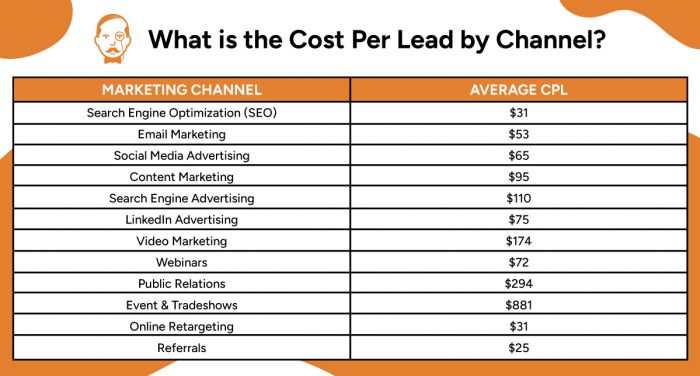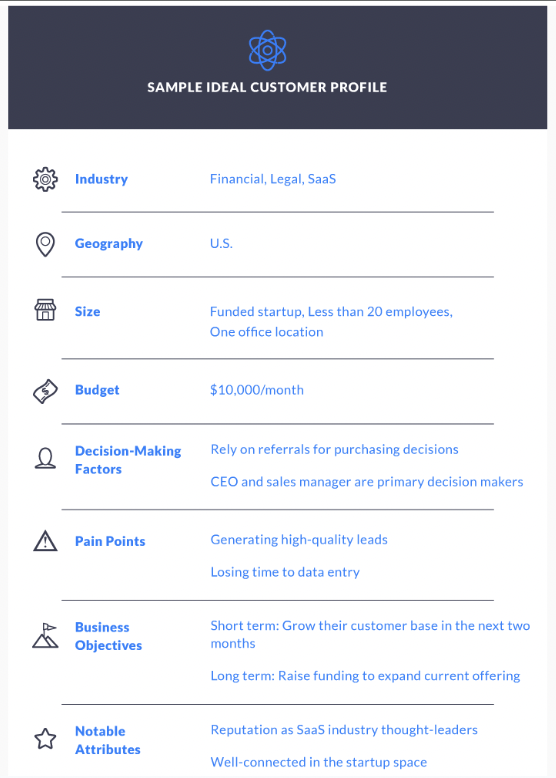The average cost of generating a lead in 2024 ranges anywhere from $40 to $200. For high-ticket industries, like financial services, technology, legal services, and real estate, this cost can go up to$400 per lead or more.
But what exactly drives these costs, and how do you ensure you’re paying the right price to get quality leads?
How to Calculate Cost Per Lead
Cost Per Lead (CPL) measures how much you’re spending to acquire each lead. To calculate your CPL, use the following formula:
CPL = Total Marketing Spend / Number of Leads Generated
So, if you spent $5,000 on a marketing campaign and generated 200 leads, your CPL would be $25.
However, to accurately determine your CPL, ensure you account for variables like the different channels, your industry, company size, and revenue–which we’ll discuss in the coming sections.
What is a Good Cost Per Lead
A good Cost Per Lead allows you to acquire potential customers at a cost that is profitable for your business. There are two key factors you must consider when determining the most reasonable CPL for your business:
- The actual cost of the lead: This is the direct amount you spend to acquire a single lead. While a lower CPL is great, it’s more important to ensure that the leads are high-quality.
- Customer lifetime value (CLV): CLV measures the total revenue you can expect from a target customer over their entire relationship with your business. A good CPL should be a fraction of your CLV—around 10-20%.
For example, if a customer brings in $5,000, then $500 might be a reasonable cost for acquiring them.
Besides aligning these two crucial factors, a good cost per lead also fits within your set budget while still allowing you to generate high-quality leads. This will ensure that your inbound and outbound lead generation efforts are not only profitable but also cost-effective.
What is the Cost Per Lead by Channel?
As mentioned earlier, the average cost per lead can differ depending on the marketing channel used. The table below shows the costs for various lead generation channels.

These figures can vary based on the industry, target audience, and lead generation processes. Still, these averages serve as a benchmark to help you understand what to expect and how to budget for different channels in your lead generation strategy.
What is the Average Cost Per Lead by Industry
The average CPL can vary not only by industry but also by the size of the company and its revenue.
Industry
Here’s an overview of the average CPL across different industries in 2024:
Company Size
Your company size can also determine your lead generation pricing. However, it’s harder to determine the average CPL for a certain company size because it depends on varying factors like industry, target audience, and marketing strategies.
For instance, larger companies may pay a lower cost per lead since they have a stronger brand authority and access to more sophisticated marketing resources.
Still, some smaller businesses that choose a mix of cost-effective strategies and have lower overhead costs may pay lower CPL. Small businesses are also more agile, which allows them to quickly adapt and optimize their marketing campaign spending.
Company Revenue
Companies with higher revenue can allocate more funds to their marketing efforts, allowing them to invest in more effective campaigns that help lower their CPL.
However, low-revenue companies that use more focused and cost-effective marketing strategies can also ultimately pay lower CPL.
Factors Influencing Lead Generation Service Costs
Here are some of the key factors that influence lead generation pricing.
1. Target Audience
Targeting a specific niche market usually leads to higher costs because these leads are more difficult to find and require more personalized marketing efforts.
A broader audience might have a lower cost per lead since they don’t require any specialized efforts. However, the quality of leads may vary. This could negatively impact your ROI, leading you to spend more.
How easily you can reach your target audience also affects costs. If they are active on common online platforms and channels, it might be cheaper. Otherwise, you’ll need to invest more in specialized channels.
2. Campaign Duration
Short-term campaigns tend to cost more per lead, especially if you need to generate a high volume of leads quickly. The urgency will demand more intensive and costly marketing tactics.
Conversely, long-term campaigns allow you to spread out your lead generation efforts over a longer period. This allows you to adjust your strategies over time, leading to lower CPL.
3. Industry and Competition
The industry you’re operating in and the level of competition within that industry also significantly influence lead generation pricing.
Industries such as finance, legal services, and technology usually have higher costs per lead because of intense competition for high-quality leads. More businesses are bidding for and targeting the same audience, meaning you will have to pay more to attract valuable leads.
4. In-House Vs. Agency
In-house lead generation can be very cost-effective, especially if you already have a skilled sales team. However, it requires significant initial investment in tools, systems, and resources.
For instance, you will have to build email lists from scratch and also warm up emails to build a good sender reputation.
Lead generation agencies, however, provide access to specialized levels of expertise and resources. They often have established processes, tools, and experienced personnel dedicated to lead generation. The level of efficiency lead generation companies offer will lead to lower costs in the long run.
If you’re looking to run things in house then cold emailing will be a core part of what you’ll do. Voila Norbert’s email sequences feature is the most effective and affordable option on the market.
Here’s how it works:
How to Reduce Your Cost Per Lead
Here are several strategies you can implement to lower your CPL while still maintaining or improving the quality of the leads you generate:
Define Your Target Audience
When you know exactly who you’re trying to reach, you can tailor your efforts and marketing budget more effectively. This ensures that you are attracting high-quality leads who are more likely to convert. Additionally, you avoid the wastage of resources associated with competing for a broad audience.
To identify your ideal audience, conduct extensive market research and leverage data from your existing customer base. Ensure you note the demographics (age, gender, location), psychographics (interests, values, lifestyle), and behavior patterns.
Based on your overall analysis, create an Ideal Customer Profile that represents your ideal customers.

Your buyer persona will help guide your marketing strategy, so you can get the most from your lead generation efforts without overspending.
Invest in the Right Technology
Having the right technology allows you to automate processes, optimize your efforts, and make data-driven decisions that lead to more efficient and cost-effective lead generation. This not only reduces your Cost Per Lead but also improves the overall quality of the leads you generate.
Some tools you can invest in include marketing automation platforms, CRM systems, email extractor software, lead scoring tools, and analytics tools.
Test Your Messaging
Testing your lead generation campaigns’ messages regularly helps you identify the content types that get the most attention from your audience. When you know what works, you can use it more often. You won’t have to waste money on ineffective messages that don’t get results.
For instance, say you notice that certain sales pitches resonate best with your audience. You can identify the tone and style in those effective sales pitches and replicate them in your other marketing messages for more effective communication.
Measure Key Metrics
Regularly tracking key metrics like conversion rates, click-through rates, customer acquisition costs (CAC), and CLV can help to optimize your campaigns. These metrics show you what’s working and what’s not.
Therefore, monitoring these metrics helps you make data-driven decisions that help reduce your CPL while maximizing ROI. For instance, if a channel like email marketing is performing well, you can allocate more of your budget to effective strategies like cold email outreach that help you get more quality leads.
In Closing
So, how much does lead generation cost in 2024? Lead generation pricing varies widely from one business to the other. This is due to factors like the industry, marketing channels, target market, company size, campaign duration, and business goals.
To reduce your CPL without cutting corners, define your target audience, invest in the right technology, test your messaging, and measure key metrics regularly.